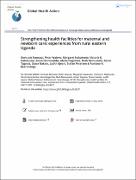| dc.contributor.author | Namazzi, Getrude | |
| dc.contributor.author | Waiswa, Peter | |
| dc.contributor.author | Nakakeeto, Margaret | |
| dc.contributor.author | Nakibuuka, K. Victoria | |
| dc.contributor.author | Namutamba, Sarah | |
| dc.contributor.author | Najjemba, Maria | |
| dc.contributor.author | Namusaabi, Ruth | |
| dc.contributor.author | Tagoola, Abner | |
| dc.contributor.author | Nakate, Grace | |
| dc.contributor.author | Ajeani, Judith | |
| dc.contributor.author | Peterson, Stefan | |
| dc.contributor.author | Byaruhanga, Romano | |
| dc.date.accessioned | 2021-04-16T09:54:06Z | |
| dc.date.available | 2021-04-16T09:54:06Z | |
| dc.date.issued | 2015-03 | |
| dc.identifier.citation | Namazzi, G., Waiswa, P., Nakakeeto, M., Nakibuuka, V.K., Namutamba, S., Najjemba, M., Namusaabi, R., Tagoola, A., Nakate, G., Ajeani, J. and Peterson, S., 2015. Strengthening health facilities for maternal and newborn care: experiences from rural eastern Uganda. Global health action, 8(1), p.24271. | en_US |
| dc.identifier.issn | 1654-9880 | |
| dc.identifier.uri | http://hdl.handle.net/20.500.12280/2662 | |
| dc.description.abstract | Background: In Uganda maternal and neonatal mortality remains high due to a number of factors, including poor quality of care at health facilities.
Objective: This paper describes the experience of building capacity for maternal and newborn care at a district hospital and lower-level health facilities in eastern Uganda within the existing system parameters and a robust community outreach programme.
Design: This health system strengthening study, part of the Uganda Newborn Study (UNEST), aimed to increase frontline health worker capacity through district-led training, support supervision, and mentoring at one district hospital and 19 lower-level facilities. A once-off supply of essential medicines and equipment was provided to address immediate critical gaps. Health workers were empowered to requisition subsequent supplies through use of district resources. Minimal infrastructure adjustments were provided. Quantitative data collection was done within routine process monitoring and qualitative data were collected during
support supervision visits. We use the World Health Organization Health System Building Blocks to describe the process of district-led health facility strengthening.
Results: Seventy two per cent of eligible health workers were trained. The mean post-training knowledge score was 68% compared to 32% in the pre-training test, and 80% 1 year later. Health worker skills and competencies in care of high-risk babies improved following support supervision and mentoring. Health facility deliveries increased from 3,151 to 4,115 (a 30% increase) in 2 years. Of 547 preterm babies admitted to the newly introduced kangaroo mother care (KMC) unit, 85% were discharged alive to continue KMC at home. There was a non-significant declining trend for in-hospital neonatal deaths across the 2-year study
period. While equipment levels remained high after initial improvement efforts, maintaining supply of even the most basic medications was a challenge, with less than 40% of health facilities reporting no stock-outs.
Conclusion: Health system strengthening for care at birth and the newborn period is possible even in low-resource settings and can be associated with improved utilisation and outcomes. Through a participatory process with wide engagement, training, and improvements to support supervision and logistics, health workers were able to change behaviours and practices for maternal and newborn care. Local solutions are needed to ensure sustainability of medical commodities. | en_US |
| dc.language.iso | en | en_US |
| dc.publisher | Co-action Publishing | en_US |
| dc.relation.ispartofseries | Global health action;8(1) | |
| dc.subject | Health System Strengthening | en_US |
| dc.subject | Maternal Care | en_US |
| dc.subject | Newborn Care | en_US |
| dc.subject | Neonatal Mortality | en_US |
| dc.subject | Kangaroo Mother Care | en_US |
| dc.subject | Uganda | en_US |
| dc.title | Strengthening Health Facilities for Maternal and Newborn Care: Experiences from Rural Eastern Uganda | en_US |
| dc.type | Article | en_US |


